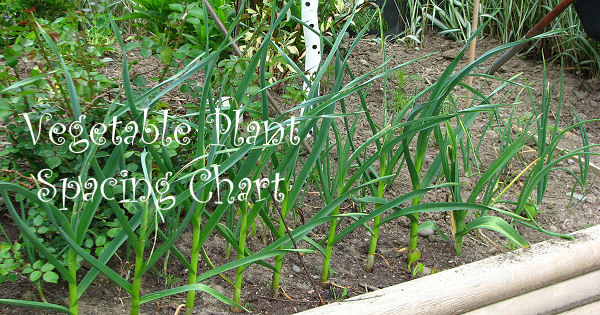33 Vegetable Spacing and Thinning Chart

Plant Spacing and Thinning:
First I go by what the seed instructions says and then I go my own experience.
If you live in a dry climate, plant roots have to search farther for water and will benefit from wider spacing than the seed instructions suggests.
I grow in raised beds so I could plant my crops closer together, but I still have very heavy clay soil.
When it's time to thin seedlings I use a scissors and clip them off so I won't be disturbing the other seedlings.
Or I just wait until it rains or my soil is moist and just gently lift the thinning's and use them somewhere else in the garden.
Understanding Vegetable Plant Spacing:
Vegetable plant spacing refers to the distance between plants in your garden. Proper spacing ensures that each plant has enough room to grow and receive adequate sunlight, water and nutrients. Overcrowded plants can lead to competition for resources, increased susceptibility to pests and diseases and reduced yields.
Factors Influencing Plant Spacing:
Type of Vegetable:
Different vegetables have different space requirements.
Small root vegetables, like radishes need less space compared to larger plants like squashes. Check specific spacing recommendations for each type of vegetable you plan to grow and then make it work on your own space.
Example - onions. I don't need large onions, so I grow them closer than the recommended spacing.
Growth Habit:
Bushy Plants: Plants like tomatoes and peppers that grow bushy, should be spaced further apart to accommodate their spread.
Root Vegetables: Plants like carrots, Kohlrabi, onions and beets require spacing to ensure roots have room to develop properly.
Vining Plants: Vegetables like cucumbers and melons that spread out or climb, need more space between rows or plants. I usually plant melons at the end of a bed so they will have the paths to spread on if they need to. :)
Garden Layout:
Consider your garden layout and whether you are using raised beds, rows, or a square-foot gardening method. Different layouts may influence the amount of space available. I have raised beds and I plant closer than the chart recommends.
Climate and Soil Conditions:
In warmer climates or sandy soils, plants might need more space due to increased evaporation and faster soil drainage. Conversely, in cooler or more fertile soils, plants might be spaced closer together.
General Spacing Guidelines:
Here are some general spacing recommendations for common vegetables:
- Lettuce: 6-9 inches apart
- Spinach: 4-6 inches apart
- Swiss Chard: 12-18 inches apart
Leafy Greens
- Carrots:-4 inches apart
- Beets 4-6 inches apart
- Radishes: 1-2 inches
Root Vegetables
Measuring Plant Spacing
If you don't have a tape measure, you can use these approximate measurements:
Foot: About 12 inches
Hand: The span from your baby finger to thumb is roughly 6 inches
Elbow to Middle Finger: Approximately 18 inches
Middle Finger to Nose: About 36 inches (1 yard)
You can also use a pre-marked board or ruler for accurate spacing.
- Read Seed Packets: Always refer to the specific spacing instructions on seed packets or plant labels.
- Thinning: If you start with seeds, thin seedlings according to the recommended spacing to prevent overcrowding.
- Adjust Based on Growth: Monitor your plants and adjust spacing if needed as they grow.
- Consider Companion Planting: Some plants can benefit from being planted close to others. Research companion planting for mutual benefits
- Use a Grid: For square-foot gardening, use a grid system to space plants efficiently.
Tips for Optimal Spacing:
Vegetable Plant Spacing Chart:
Remember to regularly check and adjust spacing as your plants grow to maintain optimal conditions throughout the growing season.
| Vegetable | Vegetable Plant Spacing |
|---|---|
| Beans | 4 - 9" |
| Beets | 2 - 6" |
| Brocolli | 15 - 18" |
| Brussels Sprouts | 15 - 18" |
| Cabbage | 15 - 18" |
| Carrots | 2 - 3" |
| Cauliflower | 15 - 18" |
| Chinese Cabbage | 10 - 12" |
| Collards | 12 - 15" |
| Corn | 18" |
| Cucumbers | 18 - 36" |
| Eggplant | 18 - 24" |
| Kale | 15 - 18" |
| Kohlrabi | 5" |
| Leeks | 2 - 6" |
| Lettuce | 6 - 9" |
| Melons | 24 - 36" |
| Okra | 12 - 18" |
| Onions - bulb type | 4 - 6" |
| Onions, Bunching | 2 - 3" |
| Parsley | 4 - 6" |
| Peas | 2 - 6" |
| Peppers | 12 - 15" |
| Potatoes | 10 - 12" |
| Pumpkins | 24 - 36" |
| Radishes | 2 - 3" |
| Spinach | 4 - 6" |
| Squash | 24 - 36" |
| Sweet Potatoes | 10 - 12" |
| Swiss Chard | 18 - 24" |
| Tomatoes | 18 - 24" |
| Turnips | 4 - 6" |
| Zucchini | 6 - 8" |
Grow and Harvest - 25+ Vegetables
Growing Food
Table of Contents
more at
Canadian Gardening